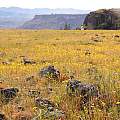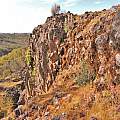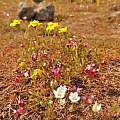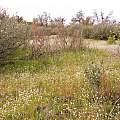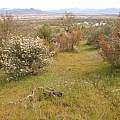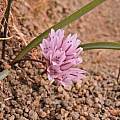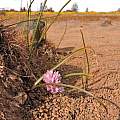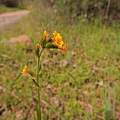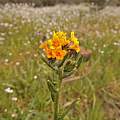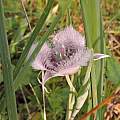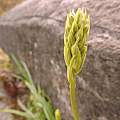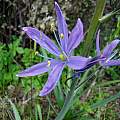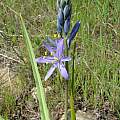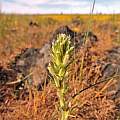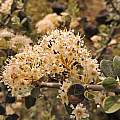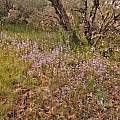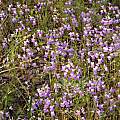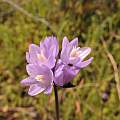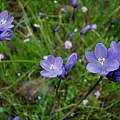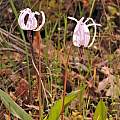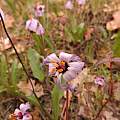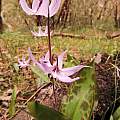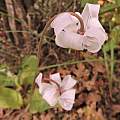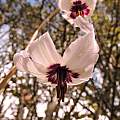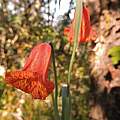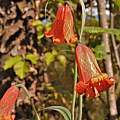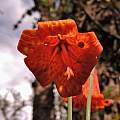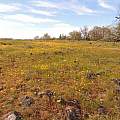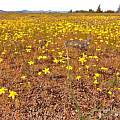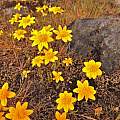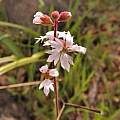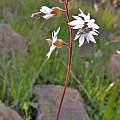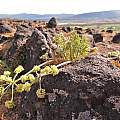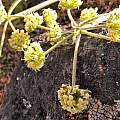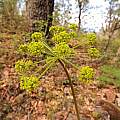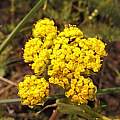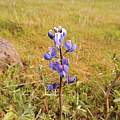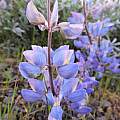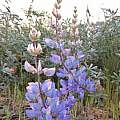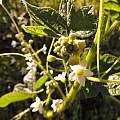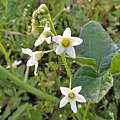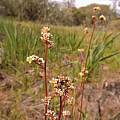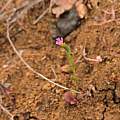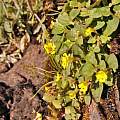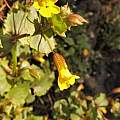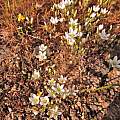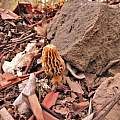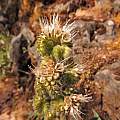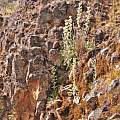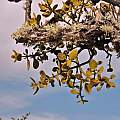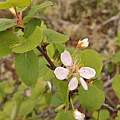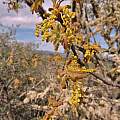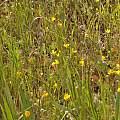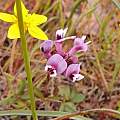Table Rocks are two prominent volcanic plateaus located in Jackson County, Oregon. They are composed of Andesite, an igneous volcanic rock similar to basalt in density. The lava that created the Table Rock formations is believed to have been deposited in an ancient cliff formation of what was known as the "Ancestral Rogue River" by an ancient lava flow over seven million years ago. Over millions of years, the softer rock in the surrounding countryside eroded away, so the Table Rocks (Upper and Lower Table Rock) now stand about 800 ft tall above the surrounding landscape.
Multiple ecological habitats (or biomes) are found on the formations, each with a different mix of flora and fauna.
- Oak savanna is predominantly dominated by Oak (Quercus sp.) trees with grassland intermixed, as well as some shrubs such as Ceanothus and Toxicodendron. This biome is found on the lower stretches of the Table Rocks, and is a common ecological habitat in the region. Erythronium hendersonii blooms in mass here under the filtered sunlight as well as multiple other geophytic species.
- Chaparral covers large areas of the Table Rock formations, consisting mainly of Ceanothus, Arctostaphylos, Toxicodendron, and other shrubs. Many geophytes cover this biome such as Calochortus, Dipterostemon, and Camassia. Fire is important in this biome, as the Ceanothus and Arctostaphylos seeds will not germinate without it. Fire also helps control the complete takeover of the woody shrubs and grasses that would overwhelm the lesser geophytes and various other wildflowers. The current joint land managers, The Nature Conservancy and the Bureau of Land Management routinely clear brush and burn small patches to reproduce the effect of wildfire in a way that is safe for the "neighbors" (farms and small communities).
- Mixed woodland consists of a dense forest of many different types of trees, including Quercus, Arbutus, Pseudotsuga, and some Calocedrus. Shrubs like Toxicodendron and Mahonia are also found here. Similar to the Oak savanna, Erythronium hendersonii blooms in mass here under the filtered sunlight along with multiple other geophytic species.
- The Plateau is unique to the region, consisting of a shallow bed of topsoil on a relatively shallow layer of almost impermeable rock. This allows the formation of vernal pools which some species of plants rely on to survive. The plateau has very few shrubs and trees, and they are restricted to the edges but not the cliff sides. The endangered vernal pool fairy shrimp (Branchinecta lynchi) live in these temporary water sources, breed quickly, and lay eggs before the pools dry out around the start of summer. Multiple species of Allium as well as some other geophytes reside on the plateaus.
The Native Plant Society of Oregon (NPSO) put out a newsletter about the flora of the Table Rocks. It contains an incomplete list of the flora found on the formations, as well as highlights of a few species unique to the Rocks. See the PDF here. Also, here is a brochure produced by the BLM about Table Rocks, including a map, directions, and some other useful information. BLM and The Nature Conservancy also worked together to produce this fine Management Plan for the Table Rocks. It covers traditional usage by the Native Americans, wildlife, fire ecology, plants, and recreational use among other things.
Allium parvum is one of the wildflowers of the plateaus. This one photographed was found hugging a rock that was directly in the center of the main trail on the plateau of Upper Table Rock, yet its small size kept it out of harms way (by foot traffic, that is).
Amsinckia menziesii var. intermedia, or Fiddleneck is a beautiful member of the borage family (Boraginaceae), sharing the traits of the scorpioid cyme and hairy leaves. These plants grow to about sixteen inches with little branching. Var. intermedia differs from the type, var. menziesii, by having yellow dots in the throat. Amsinckia menziesii var. intermedia occurs in small disjunct groups on the hillside in association with Ceanothus cuneatus, Plagiobothrys sp., and others in the chaparral.
Chalochortus tolmei is fairly common on Table Rocks. It is in bloom April or May.
Camassia sp. grow en masse on the bottom third of the Upper Table Rock trail, though aren't in bloom until mid to late April. The first photo taken by Travis Owen. The next two taken April 2017 by Mary Hunter.
Castilleja sp. are considered "hemiparasites" of grasses, other herbs, or possibly tree roots. They are known to be difficult in cultivation, if possible at all, due to their excessive demand for nutrients.
Ceanothus cuneatus is the dominant shrub in the chaparral, along with Arctostaphylos sp. When in bloom they fill the air with a musky sweet scent not unlike fruit trees (particularly Prunus). Bees and butterflies visit the flowers.
Collinsia sp. Blue-eyed Mary, or Chinese houses, are an eye catching member of the Plantaginaceae (figwort family). I have only ever seen them in large masses, which makes them seem much larger than the meager six to eight inch heights they achieve. The small bilaterally symmetrical flowers with two upper lobes and three lower lobes. The genus consists of around twenty species of annual herbs, all endemic to North America.
Dipterostemon capitatus (syn. Dichelostemma capitatum) resides by the trail growing up through the open growth habit of buckbrush (Ceanothus cuneatus). They don't seem to grow in clumps, but rather as isolated individuals. First photo and text by Travis Owen. The second photo from Mary Hunter.
Erythronium hendersonii blooms en masse March to April mostly in the oak savanna and mixed woodland habitats, though also in the chaparral. Many various forms pop up showing just how variable this species is.
Fritillaria recurva grows alongside the trail at various locations, mostly in shaded protected areas close to treed or shrubs.
Lasthenia californica covers the plateau's in March and April, filling the air with a honey-like fragrance.
Lithophragma glabrum Bulbiferous woodland star is a member of the Saxifragaceae (saxifrage family) native to Northern California north through Oregon and Washington to British Columbia, and east to the Dakotas and Colorado. It grows from a slender rhizome, and produces tiny bulbils at the leaf axils which will form new plants if broken off.
Lomatium sp. are very widespread in Oregon. Many were used medicinally by the Native Americans or as a food. They very in height, habit, and habitat.
Lupinus sp.
Marah oreganus was found growing at the lower end of the Upper Table Rock trail.
Micranthes nidifica var. nidifica Sometimes known as the peak saxifrage, it is a close relative of Saxifraga, the American genus Micranthes once considered to be a part of it. This species is a rhizomatous member of the genus, producing tiny flowers atop attractive red stems.
Microsteris gracilis (syn. Phlox gracilis) is a tiny flowered annual phlox with a wide distribution. It is found From southwestern Canada down through the West Coast of the United States, into some of the southern states, and south into Mexico.
Mimulus sp. tend to grow in areas with an ample water supply, like the plant pictured below, Mimulus alsinoides. It was found growing in a seep at the edge of the plateau on Upper Table Rock.
Minuartia californica (syn. Arenaria californica) covers the plateaus of Table Rocks in March and April. It is an annual herb often called California sandwort. It grows less than five inches, most often around two inches on Table Rocks.
Morel sp. are a group of edible mushrooms highly sought by chefs and mushroom pickers. They are rarely grown successfully in cultivation, if at all.
Phacelia hastata is in the Boraginaceae (or a subfamily within it). Bumblebees were very active on the flowers.
Phoradendron villosum The conspicuous green mounds often seen on oaks in winter when the leaves have fallen are the mischievous mistletoe plants, parasites on their oak hosts.
Prunus subcordata, also known as Klamath plum, produces tiny tart yet edible plum-like drupes in the late summer.
Quercus garryana, or gary oak
Ranunculus sp. are a widespread genus of both tuberous and fibrous rooted plants. The Ranhnculus sp. native to Oregon are fibrous rooted. The two species, R. occidentalis and R. austro-oreganus differ by the former being generally shorter with petals that are yellow on both sides on more open flowers, and the latter (pictured below) which has bronzey-brownish red on the backsides of the petals. R. austro-oreganus has leaves with dark markings.
Trifolium sp. Many species of clover inhabit Table Rocks. Trifolium wildenovii covers the plateaus in March and April.
